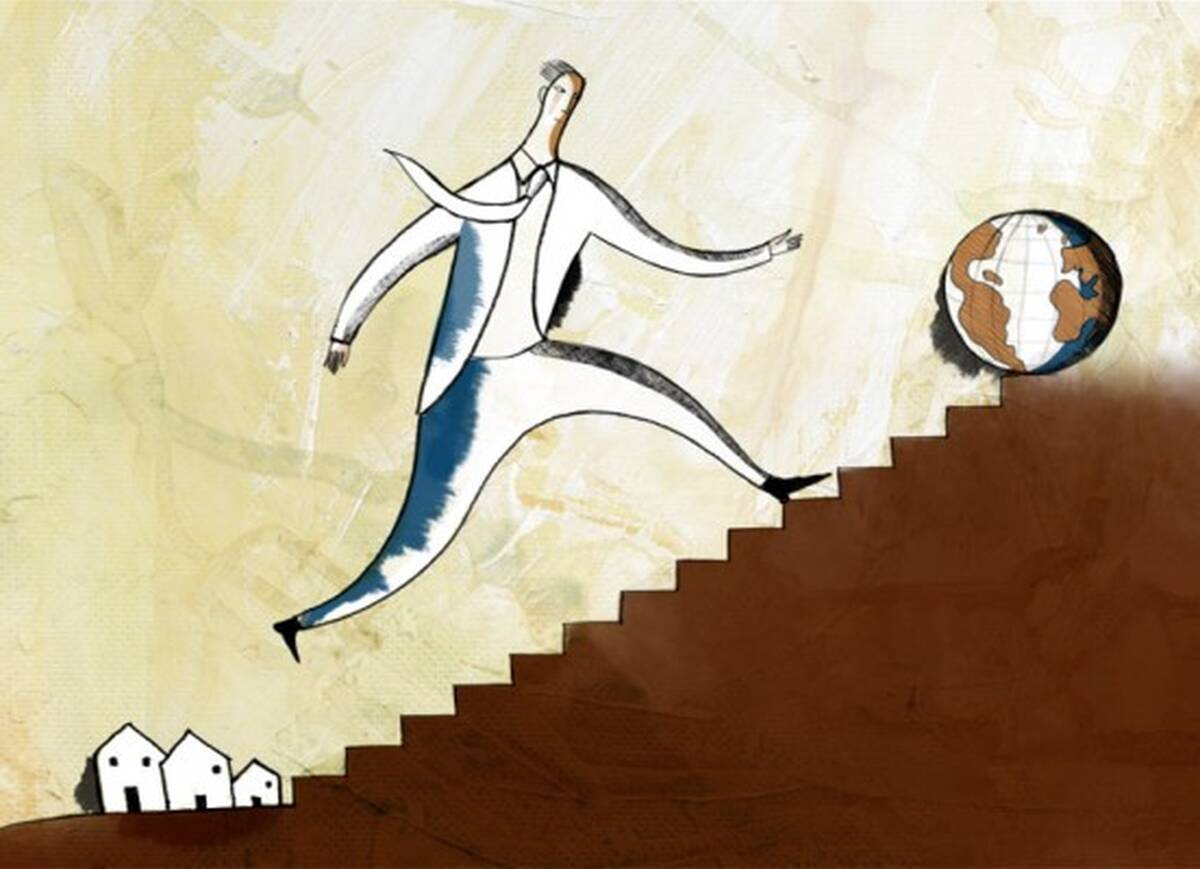Here are five insights from our faculty on the economic perils and possibilities for small businesses today.
Climate change can hit small businesses particularly hard.
In a recent study, Kellogg’s Jacopo Ponticelli and his colleagues looked at how U.S. manufacturing firms of different sizes responded to extreme weather from 1980 to 2019.
In the short term, the researchers found that especially high temperatures increased costs (mainly in the areas of electricity and fuel, for temperature management) and hampered worker productivity—but only among plants with fewer than 50 employees. Larger establishments appeared unaffected by temperature shocks in the immediate aftermath.
Over the full four-decade period, the picture for small businesses was even bleaker. Regions that warmed more quickly saw larger declines in the number of small plants but no significant change in the number of large plants. The upshot, over the long term, is higher local concentration in the manufacturing industry.
The researchers point to three potential explanations for larger firms’ adaptive superiority. First, larger manufacturing plants are more likely to be part of a national or international network, which allows them to hedge against weather shocks by moving production when necessary. A second possibility is that larger firms have more consistent access to external financing, reducing their need to lay off workers or close plants when heat waves or natural disasters strike. The final potential explanation—and the most instructive one, perhaps, for smaller firms—is the role of managerial foresight.
“It’s possible larger firms have more forward-looking managers,” says Ponticelli, an associate professor of finance. Such managers could have been investing proactively to insulate buildings, purchasing equipment less prone to overheating, negotiating better deals with electric companies, or installing solar power systems. For small firms especially, then, thinking proactively about how to contend with climate change is just good business.
When Apple began prompting iPhone users to opt out of sharing their data in 2021, it limited the ability of digital advertisers to track potential customers across apps. The move, lauded as a win for users’ privacy, ultimately cost big tech platforms billions of dollars.
But when Kellogg marketing professors Anna Tuchman and Nils Wernerfelt examined the issue, they found very few studies that showed the effect on businesses who advertised on these apps.
Tuchman, Wernerfelt, and colleagues decided to fill the gap, conducting a large-scale experiment with more than 70,000 advertisers on Facebook and Instagram. They wanted to find out just how much companies benefit from using offsite data—that is, user data tracked and shared across applications—to deliver targeted ads.
Quite a lot, as it turns out: the team found that removing the ability to use offsite data would result in a 35 percent increase in the cost to gain each new customer—and would disproportionately hurt smaller advertisers. In fact, their analysis showed that the effect of losing offsite data was five times greater for these advertisers versus larger ones. That’s because small advertisers are often little-known and rely on such offsite data and ad targeting to bring in niche incremental customers.
This downside is important to consider when crafting policy. “You can protect privacy in this manner, but it might have real costs on the advertiser side,” Wernerfelt says. “There’s no privacy ‘free lunch’ here.”
All of this might seem like tough news for small businesses. But there are lots of ways for little-but-fierce firms to get ahead.
For example: larger loans. Not surprisingly, small businesses have historically relied on relatively modest loans when seeking to grow. But Kellogg’s Dean Karlan, a professor of economics and finance, wanted to understand if and when more capital might help.
Karlan and his colleagues crafted a study that aimed at answering two big questions: Do big loans help small firms grow? And can lenders predict whether a specific firm will use a larger loan effectively?
The results showed that bigger loans had minimal impact on profits on average. But importantly, results varied widely across borrowers: top performers increased profits significantly, while poor performers saw drops, suggesting that lenders would be wise to strategically choose the recipients of larger loans.
The researchers were surprised to discover what differentiated the successful borrowers from the struggling ones. The loan recipients’ mindsets proved highly predictive, it turned out, much more so than their education and experience levels or loan officers’ predictions.
Counterintuitively, borrowers who fit the profile of a “go-getter”—agreeing strongly with the statements “Failure is not an option” and “I tend to act first and worry about consequences later,” for example—did worse with big loans. The researchers hypothesize that more reserved borrowers are more realistic about the possibility of failure and perhaps more risk averse.
So, for small business owners whose egos are in check and whose aspirations are realistic, a bigger loan might be a path to success.
Karlan has also found that small businesses can benefit from working with consultants.
Researchers know that small to medium enterprises frequently have trouble expanding past a certain size, particularly in developing economies like Mexico.
But why? One theory holds business owners might lack the skills and business savvy, such as managing people or creating a business plan, required to help their companies reach the next level.
In a 2018 study of small businesses in Mexico, Karlan and his colleagues tested whether working with an experienced consultant might make up for these gaps in managerial know-how and help companies grow.
For the experiment, 80 randomly selected firms ended up with consultants. The consultants conducted a daylong diagnostic session with each firm and then designed a consulting routine for the next year. Meanwhile, a control group of 282 companies continued operating as usual, without expert advice. A year later, the researchers found, the firms that were offered consultants saw both their productivity and their return on assets increase relative to the control group.
Over the next five years, the average firm that had received consulting grew its staff by 57 percent, while the average firm in the control group remained roughly the same size. Furthermore, total wages paid by firms that had had consultants increased 72 percent, indicating that they were increasing employees’ pay over that period as well.
After the first year of the experiment, the researchers conducted a survey asking firm owners what had made their consultant so valuable. The answers varied widely: some said the consultants improved their marketing or accounting, while others pointed to different dimensions, like pricing or human resources.
The researchers also measured the owners’ “entrepreneurial spirit” and found that owners who had been randomly selected to receive subsidized consulting said they were more goal-oriented, more driven, and more confident in their problem-solving abilities than they had been before the consulting.
The lesson for small business owners? Don’t be afraid to seek out expert advice. Your company may come out stronger for it.
While small businesses face unique challenges, they also have their own advantages.
One analysis by Kellogg marketing professor Gregory Carpenter and his colleagues suggests that companies with smaller budgets can spend their R&D dollars differently than industry giants—and realize bigger increases in their sales and stock prices.
The researchers built a statistical model to assess how investments in different areas influenced product sales for 2,500 companies of all sizes across different industries. They found that while sales in the pharmaceutical industry were significantly affected by both marketing and R&D spending, consumer goods were only affected by marketing: R&D investment overall had little impact on sales.
Further analyses, however, revealed a difference between the very largest companies in their sample and smaller firms. Unlike their giant peers, smaller firms with more-modest R&D budgets did see a significant impact of R&D spending on sales.
Lastly, the researchers compared the performance of giants P&G and Unilever with that of the far smaller Reckitt Benckiser. They found that in the past ten years, Reckitt Benckiser’s stock prices rose nearly 138 percent—over four times more than P&G and Unilever.
The difference, the team suggests, stems not from the amount a company spends on R&D, but how it spends those dollars. Instead of aiming for big breakthroughs, Reckitt Benckiser’s modest R&D spending was aimed at meeting specific consumer needs, which produced a sequence of incremental but meaningful innovations rather than an occasional blockbuster.
Larger firms could take a lesson from this success story by incorporating more customer research into R&D efforts. “For a lot of consumer-goods firms,” Carpenter says, “that really means elevating the importance of R&D and making them influential members of the team.”



